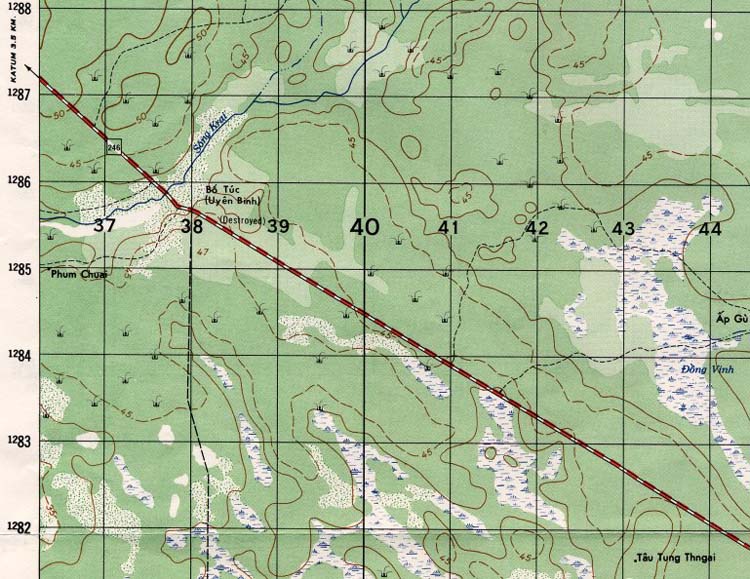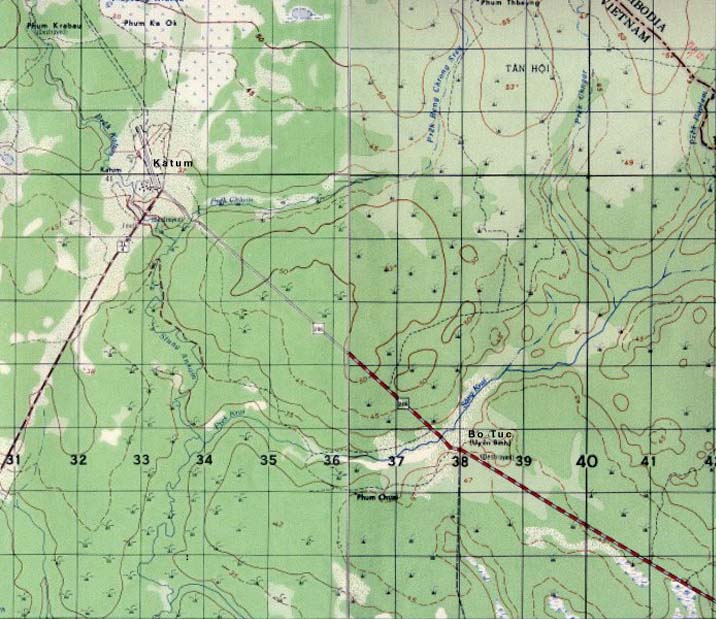Bo Tuc December 1967
Bo Tuc December 1967 Bo Tuc (Lake of Fire) Listening Post by Bill Kelly Listening Post by Keith Bolstad Maps of AO - Bo Tuc
"MY RECOLLECTIONS"
By: Colonel (Retired) John M. Henchman
4th Battalion CO
Oct. 1, 1967 -March 3, 1968
The Background:
Division intelligence indicated that because we set up a very powerful base of operations in Katum which I mentioned earlier was astride the "Ho Chi Minh" trail it forced the VC/NVA to move around this "island" to the east and west.
About December 16 or 17, Colonel Marks ordered us to prepare a lift into an abandoned village about 4 KM east from Katum on 19 December. Fresh intelligence indicated heavy movement of enemy units down a major trail complex that went through Bo Tuc. [Of course, what no one knew at the time was that the NVA was moving major forces south into assembly areas near Saigon in preparation for their major TET offensive, in January 1968)
Based on the intelligence, we were sure we would get some strong probes at night. Therefore, the plan we developed called for us to put in a four company perimeter with our mortars, an artillery battery and the battalion CP in the center. We expected to occupy that position for about a week, and made preparations accordingly including stockpiling small arms, mortar and artillery ammunition in case we had a major attack at night and couldn't get resupply.
The Insertion December 18:
Troops left the PZ-Katum airstrip early afternoon. I do not remember which company went first. The LZ was "cold". By the time the second company arrived, the first company was taking sniper fire and some light mortar fire, and had begun to immediately dig in. I put the second company in, and they got the same treatment. This created a situation where the first two companies in did not take up a wide enough front. I was overhead in the C&C helicopter. I could see that we were going to have too small a perimeter. I told all the companies to move out farther, but with all the incoming, that was a problem. Al Baker, I remember, argued for staying put. I had to agree, but I was concerned how tight we would be . We still had C Company and the artillery battery to go in, plus all the ammo. I put in the third company which completed the perimeter. Incoming fire continued to be sporadic. It was now A, B, and D on line. There was no alternative, then, to wrapping Charlie Company around the artillery in the middle. The artillery and all its ammo, and our mortars and ammo, went in next by CH-34, followed by Charlie Company just before dark. Sporadic mortar and sniper fire continued. There was so little room in this organization of the terrain, that the battalion CP was actually on the outer perimeter with one of the companies. In the end, this weird organization "saved our bacon."
The Battle:
Early morning hours, December 19: Sometime around 0200, I received reports of major movement coming south into our area. Mortar fire increased in volume and size. I ordered our defensive fires increased, firing 155MM from Soui Cut (FIRE BASE BURT), 105MM from Katum. I alerted ISSUE 11 (or FAC, with his little Birddog at Katum) that I thought we were going to get hit hard. He went airborne at about 0300. At about 0300, the incoming mortar fire became intense, and the enemy attacked three sides of the perimeter with what was later described as the major part of a NVA Regiment. All companies were fully engaged, but the line was breached. NVA were inside the perimeter, attacking the artillery and its ammo supply. They ran smack into another perimeter inside the outer one--Charlie Company. It confused them very much, but they did not back away.
Some company commander-Killgrove?--called on the radio and said that you couldn't tell the bad guys from the good guys too many of both moving around outside the holes. I remember the order I issued "Every GI in a hole in the next five minutes after that anything moves above ground is NVA. Shoot to kill". Maybe the riskiest order I ever issued in combat. The Artillery LNO asked permission to use "beehive ammo" in a direct fire mode even though that might possibly create casualties among MANCHUS. (I reasoned that if everyone was in a hole, the risk was acceptable.)
You all remember the tough fight, artillery and mortar ammo exploding from sachel charges the NVA had placed on them, rounds "cooking off ' all over the area, now jets coming in about 0430, the 8 inch battery cut in about that time, I had requested SPOOKY (the airmobile fixed wing mounted with gattling guns) but it was busy somewhere else. Our FAC (ISSUE 11) was overhead all the time, almost crashed on the road. .His binoculars had become jammed in the rear seat's controls. He left his pilot's seat, went into the back, freed the jam, and got back in the cockpit - all the while the plane was flying itself and loosing altitude. He pulled out at about 200 feet. As usual, he was cocky, flying low, dropping hand grenades, but most importantly working a lot of jet aircraft he had on station.
I wasn't there
Other than the tragedy at Hoc Mon Bridge, March 2,1968,- this was my worst day in Vietnam. I wasn't where you were when I should have been. Here is what happened:
When I landed at Bo Tuc just about 1600 (all the companies were in, and the artillery was just getting settled), there was no CSM there with the CP element. I called Tay Ninh and ordered him to be in Katum in one hour. I got a ride back to Katum with one of the CVH-34, expecting to get him and bring him back with me. He was there at Katum about 1700, but there were no helicopters available to bring us back to Bo Tuc, NONE. Every single one had gone back to Tay Ninh for maintenance, or were down for repair. I couldn't believe it. I was stuck. My heart was sick. I wanted to be at Bo Tuc - needed to be.
I wheeled my jeep with its good radio up next to our CP, and stayed with it all night. I was never out or control of the operation, but I WAS NOT THERE IN PERSON. That night all of Katum took a heavy mortar attack. It lasted all night. Several were wounded in the CP area.
After the battle - Early Morning - December 19
I came in at first light on the first chopper I could get. It was a terrible sight. Those of you there will remember. I walked around the perimeter. The battalion's casualty figures are as clear to me today as then: 10 killed, 35 wounded. Some of our honored dead were still in their holes - one lad had killed so many in front of his position that his machine gun fires had been masked, and he died fighting with his hands.
The area inside of the perimeter and outside was littered with 50 - 70 dead or dying NVA. How many more our small arms, mortars, the artillery, and the bombs and napalm killed, no one will ever know how many.
"Doc" Daubeek was there, crying quietly to himself, covered with blood of those he had helped and those he couldn't. I remember holding and hugging him for a couple of minutes -- in thanks for all he had done for us all.
As bad as Bo Tuc was, the MANCHUS had showed the rest of the Division what it was to be a soldier in a damn good outfit.
This was the biggest battle the Division had had up to this point. You all surely lived up to the finest traditions of our "9th Infantry Regiment" and its motto "KEEP UP THE FIRE".

1. According to the map legend the dotted area along the Song Krai is a sandy area. The light green is clear forest and the dark green is dense forest or jungle. The clump symbol indicates bamboo. The border area around Bo Tuc and Katum was thick with bamboo.
2. The map indicates Bo Tuc was destroyed. A page for the 118th AHC "Bandits" platoon shows a helicopter that was used during the evacuation of Bo Tuc in 1964

This is an attempt to put two maps together to show a little more of the War Zone C AO during Operation Yellowstone which began Dec 8, 1967. Here are some facts about this map.
1. The grid lines are 1 kilometer apart, and the dark horizontal line passing through Katum is 90. The coordinates for Katum are roughly XT330900.
2. The airstrip running north by northwest can be seen at Katum.
3. Going due north from the north end of the airstrip, the Cambodian border is about 5.5 Km. The border can be seen in the northwest corner of the map.
4. Rt TL4 running southwest out of Katum goes toward Nui Ba Den and eventually Tay Ninh. Convoys did travel that road during the operation.
5. Rt 246 runs southeast out of Katum through Bo Tuc (XT380860), the runs due east where it passes Rt 244 coming up from the south (off the map). Just south of this junction is Suoi Cut where the huge battle of FSB Burt occurred the night of Jan 1, 1968 (probably about XT500800. The Manchus relieved the 2/22nd Inf. at Burt on Jan 2. FSB Burt and FSB Beauregard (at Bo Tuc) were about 13 Km apart. The Manchus at Bo Tuc received supporting fire from both Katum and Burt.
